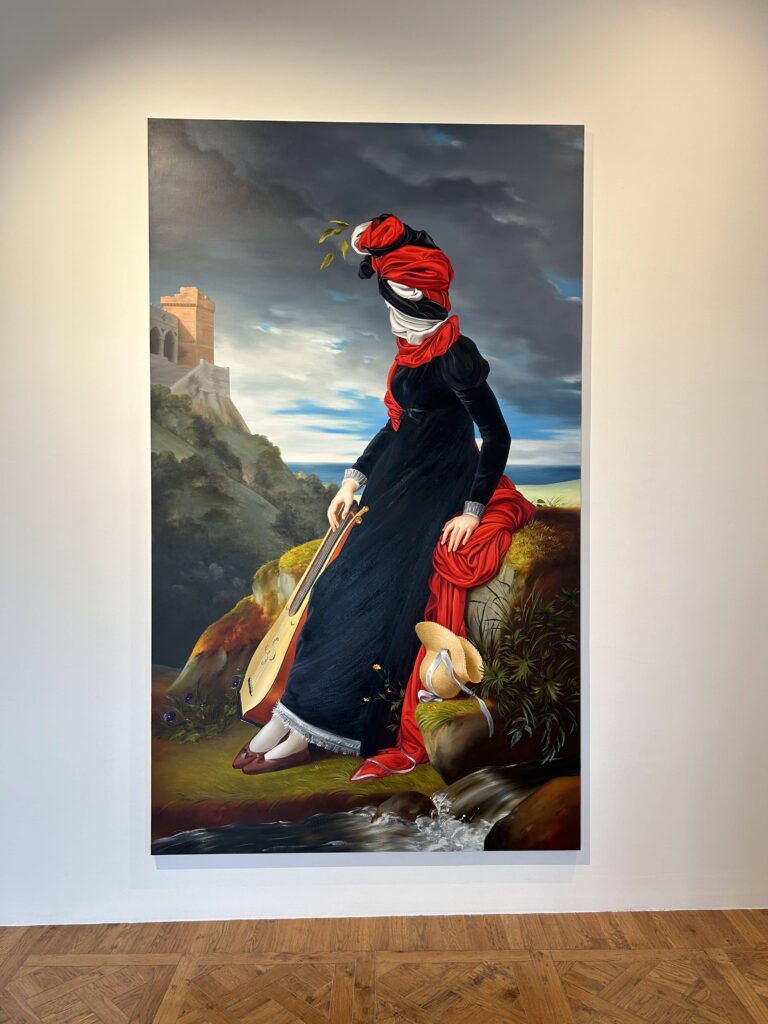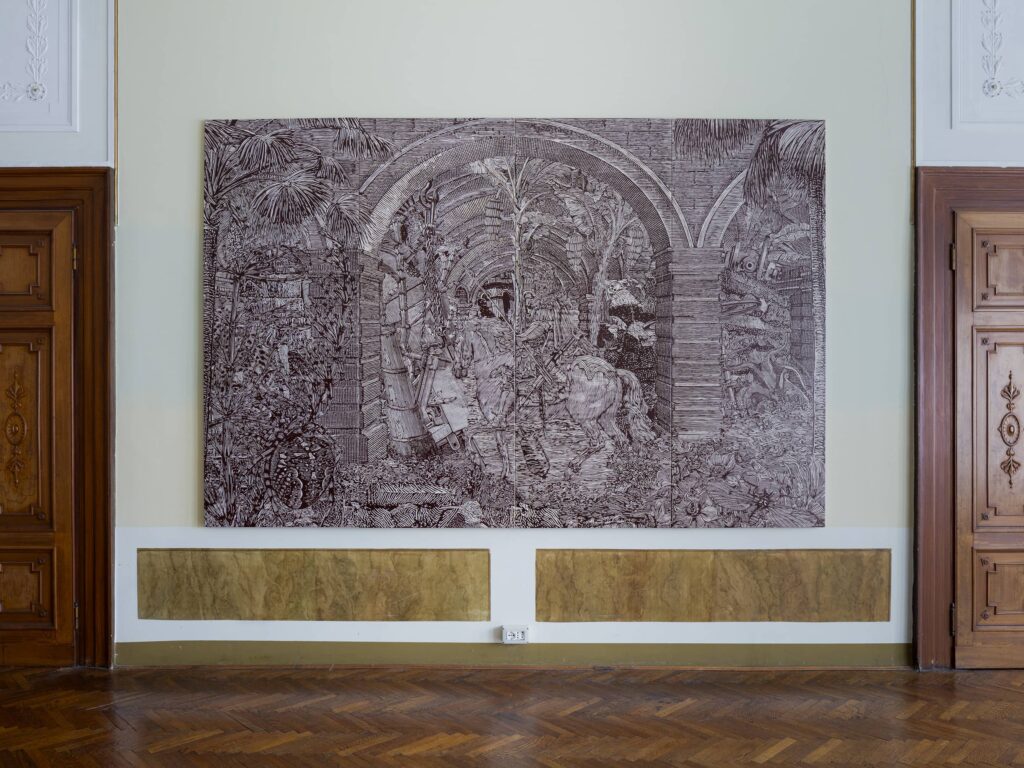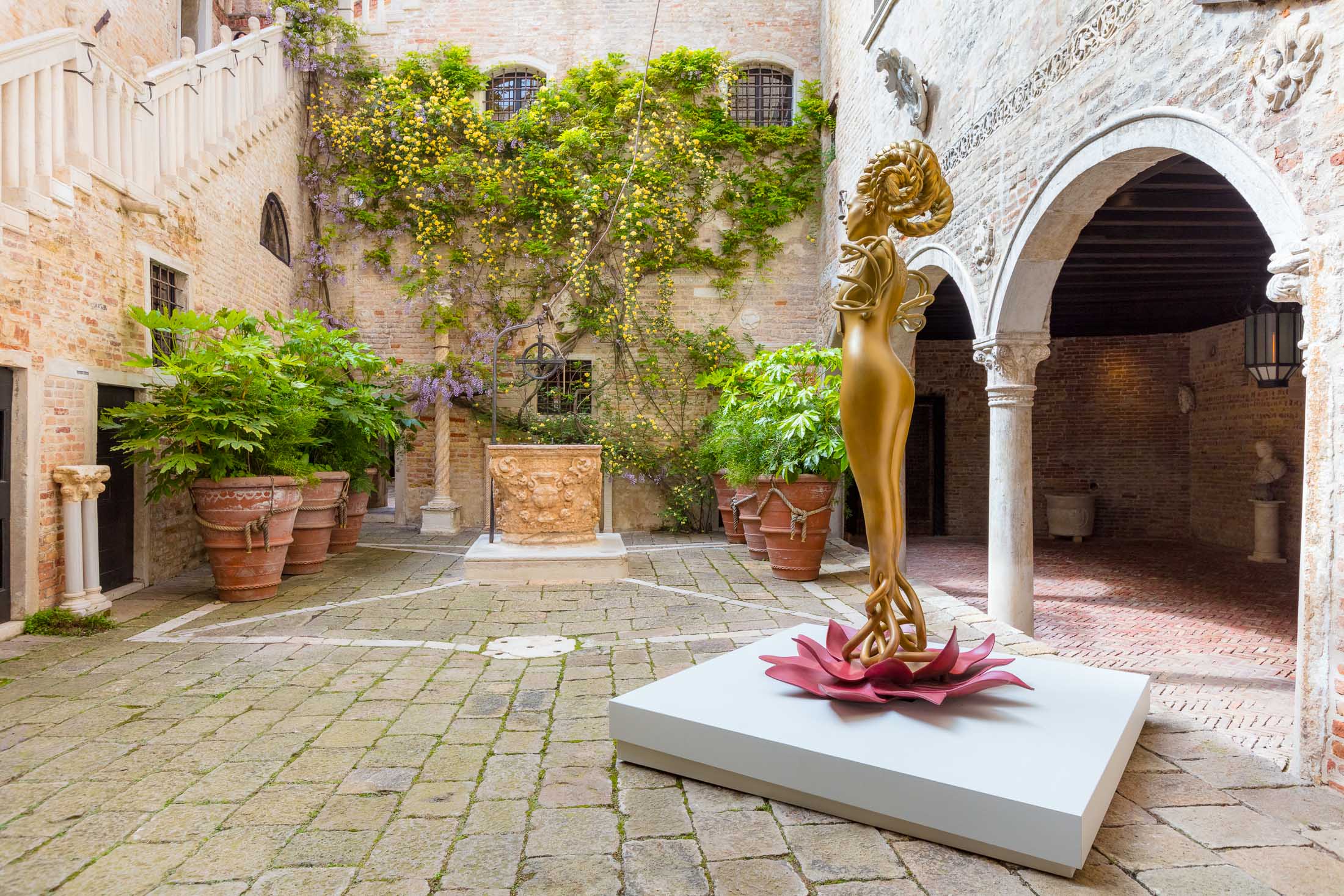Sculptor Shahzia Sikander’s show “Collective Behavior” is one of the finest examples I have seen of how fruitful it can be to juxtapose contemporary art with stunning historic architectural settings. Her sculpture “Now,” with its curving horn-like braids and squiggles for feet and arms” currently graces the courtyard of Venice’s Palazzo Van Axel.
When the work was previously shown, without any context, at the most recent New York Armory show, it was impossible to tell if it was merely a whimsical piece of high art weirdness. Set in the wildly picturesque gothic courtyard of the palazzo, though, it resembles a creature from a Persian fairy tale, which is much closer to what she intended: a symbol of cross-cultural female empowerment.
Ms. Sikander was trained in Persian miniature painting as a young woman, and the figure with what appear to be calligraphic wisps for limbs seem to express an ongoing tension between Persian traditional art, contemporary figuration, and Islamic calligraphy.
Her incredible meticulous story book scrolls reveal tiny figures going about their domestic daily business are marvels of pictorial ingenuity that borrow equally from her education in two vastly divergent art practices. It is a genuine mash up of traditional South Asian and contemporary American art making.
A similar slew of pleasing and productive contrasts can be found in the solo show at Venice of another painter with ties to New York, Rick Lowe. Currently represented by Gagosian, his stand-out abstracts are currently showing in the magnificent Museo de la Palazzo Grimani. A self-professed compulsive, Mr. Lowe walked me through his detailed painting process, which consists of cutting and applying paper to already patterned surfaces in several layers that he then paints over, scratches at and reconfigure.
The results are explosive abstracts that pack a visual wallop while simultaneously radiating a sense of map-like, topographical detail. This marriage of visual intensity with obsessive detailing causes a simultaneous expansion and contraction of the visual field that must be experienced in person.
The Grimani itself, a medieval building which its patriarch, Giovanni Grimani, “modernized” with additional architecturally designed rooms and a collection of art and antiques, provide a fascinating counterpoint.

A more sedate but no less witty counterpoint of old and new are found in Eva Juszkiewicz’s reimagining of baroque and classical portraiture. Her collateral show at the Palazzo Cavinis consists of 15 works where the costuming, hair and ornamentation central to Classical portraiture are comically overblown, to the point where they conceal the faces of their sitters entirely.
Several are recreations of aristocratic portraits by Francois Gerard, and it is her unerring technique that manages to bring off the visual critique so flawlessly. Much has been said about Juszkiewicz’s critique of female representation- the implication is that women of the aristocracy were nothing but the sum of their finery-but there is obviously a great deal of love behind such flawless attention to old school painting technique.
Nevertheless, to see baroque and classical portraiture elegantly, if not farcically deconstructed in such a timeless architectural context only amplifies their impact.
A final nod, however, needs to be made to Austrian artist Hans Weigand, who applies renaissance woodcut techniques onto canvas in a send up of renaissance print culture and doomsday sentiments in his solo show “Rising Waters/Falling Skies.”

A contemporary of German neo-expressionist giants Sigmar Polke and Martin Kippenberger, Weigand stands on his own with these canvases that blend the technical aplomb of Durer with post-apocalyptic images, punk rock surfer culture, and sci-fi steam punk elements.
Thoughtful gorillas punctuate the dense engraved madness. A beautiful send up of several centuries of art history at the Palazzo Pisani, it reminds us that much of contemporary art and, in a sense, much of what we hold culturally dear, are so many remnants being swept into the turbulent dustbin of history.
Set against the larger backdrop of the 60th Venice Biennale, which has been panned in some quarters for its blanket socio-political tokenizing and pandering, these stand-alone and collateral shows demonstrate that the work of artistic, social and historic dialogue can be done with nuance, complexity, and humor.

















Discussion about this post